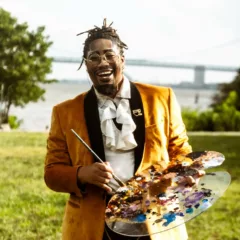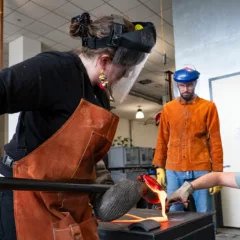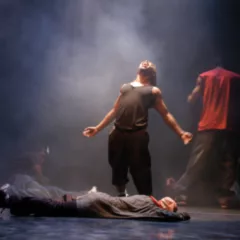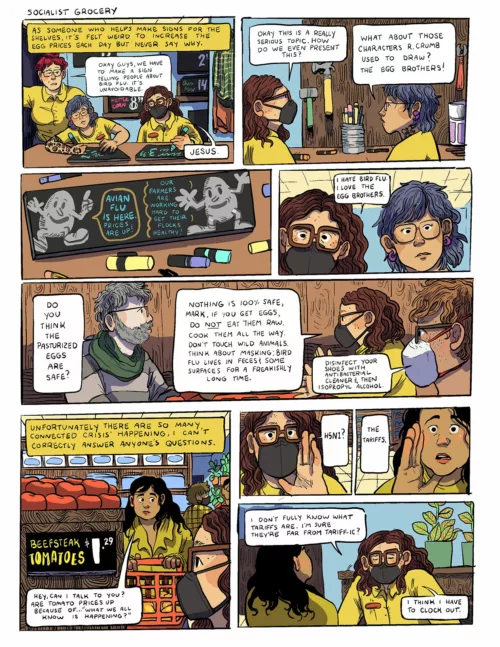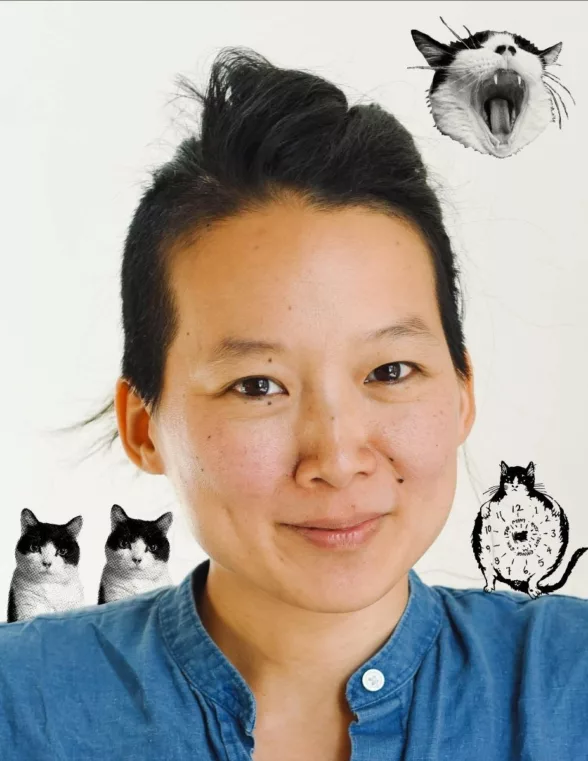
How Can We Live Together?
In Philadelphia, the word “Ulises” is synonymous with the city’s sense of art community. Ulises is a cooperative art bookstore for unusual books and independent art publications. My first purchase after they moved to a new space at Ray Philly last spring was Textdemic | A Retrospective on Jenny Holzer’s Laments featuring the works of artists, writers, and activists including Morgan Bassichis, Gregg Bordowitz, and Alexander Chee. It’s the biggest handmade GenderFail risograph book I’ve ever seen.
Ulises also serves as a scholarly platform that is stimulating and interconnected. Recently, Ken Lum, an acclaimed Philadelphia-based artist and educator, hosted a table reading of his feature-length script on Chinese workers in collaboration with local performers as part of his exhibition at Ulises’ project space. The reading was accompanied by a discussion with Peter X Feng, English Professor at the University of Delaware.
Ulises is welcoming, warm, and cozy, as a community of critical praxis fostering the dynamics of collective thinking. They were a venue sponsor for one of the Eco-Social Salons, a discussion series on the climate crisis and arts, organized by Daniel Tucker, a Philadelphia-based multifaceted writer, organizer, and artist. Every day, Ulises does more than just exist.
I was so excited when I first heard Ulises was presenting the Los Angeles artist Candice Lin’s exhibition but also surprised, to be honest. Ulises is a community-minded space that is writing a new chapter on what it means to be independent as a practice and as activism, whereas the kinds of places Candice Lin’s work has been shown – in the past five years at least – are mostly large-scale visual arts establishments attracting mainstream audiences and recognition. Her most recent show commissioned by the Biennale of Sydney and Monash University Museum of Art is currently up until January 12, 2025 at Jameel Arts Center in Dubai[1]. Her first solo show in New York was at Canal Projects[2] in 2023, presenting a gigantic installation of a lithium battery factory co-produced by Gwangju Biennale. Her work shown at the 2022 Venice Biennale[3] built off her installation at the Carpenter Center for the Visual Arts[4] and the Walker Art Center[5].
Lin, who is American, has been garnering significant international attention for her practice exploring power relations in the history of oppressions using non-human configurations and objects in fictional situations. Central to her work is disrupting and reframing preconceived notions to allow fluidity blurring the boundaries and opening up in people’s understanding. Lin’s experimentation with organic materials that are mutated and deteriorated through natural processes reflects her interest in malleability of interactions.
When I visited Ulises for Ken Lum’s table reading, Lauren Downing from Ulises briefly told me Lin’s exhibition was going to be about cats. Cats have been a recurring motif in Lin’s work. Cat demons as feline narrator appeared in different forms — videos and sculptures — in her show at the Carpenter Center. I was excited to find out more of the behind-the-scenes stories. This interview was conducted in the early morning of December 13, 2024, at Asian Arts Initiative, one day before the opening of her show at Ulises.
Sharing resources and community – in Los Angeles and Philadelphia
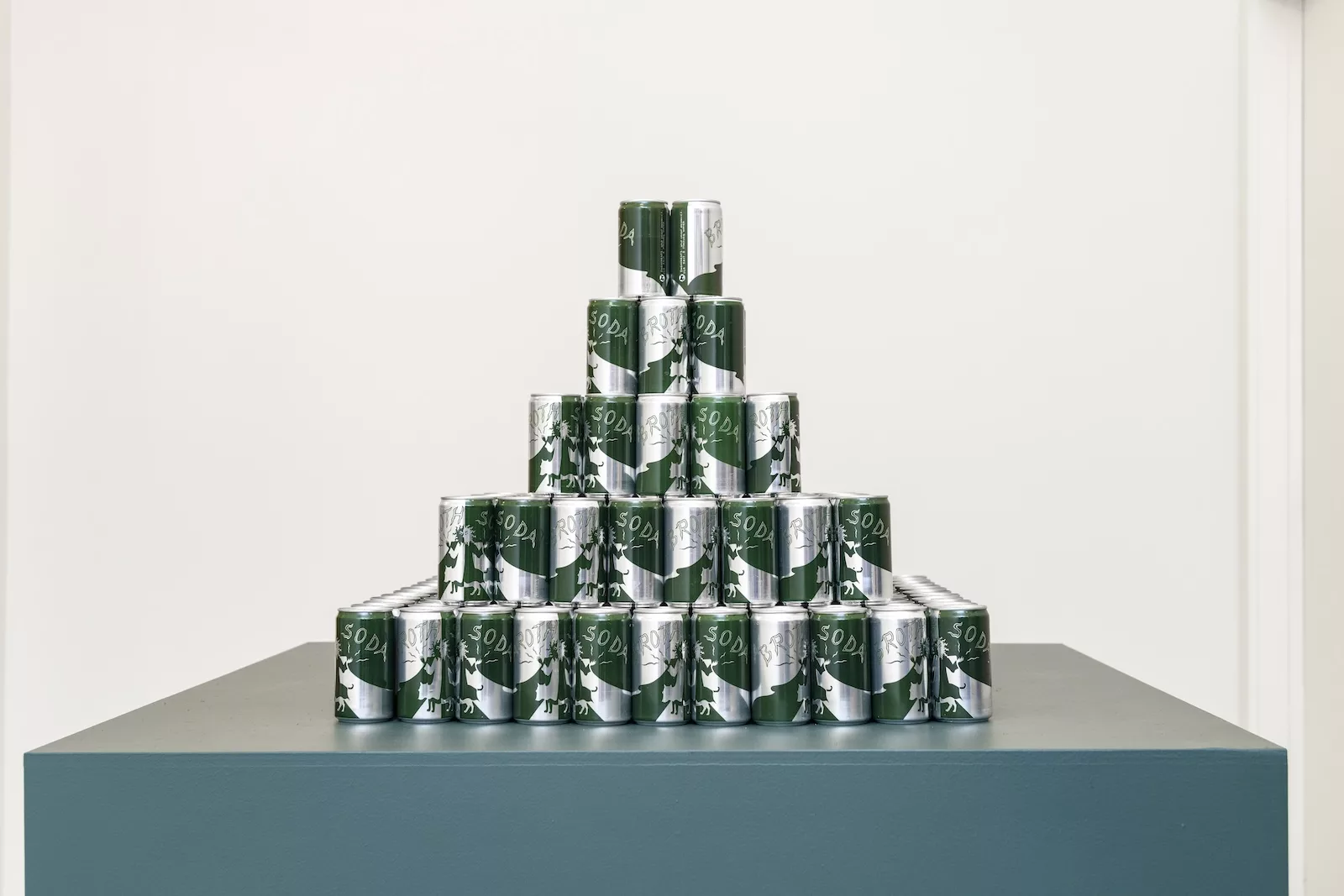
Joyce Chung: What prompted you to want to have a show at Ulises?
Candice Lin: We did a Zoom and I was so charmed by them as people. I remember we talked about their history and what they do. I felt a warm, immediate connection with them. Sometimes when you meet somebody, you feel like you are old friends so I was excited to do something with them.
Joyce: This is your first time having a show in Philadelphia. There’s a strong sense of community in the Philly art scene.
Candice: Yeah, it seems like people help each other. When we needed a pedestal of a certain size during installation yesterday, Ricky (Yanas, of Ulises) was like, ‘Let me go down the street and ask these people.’ That’s great in so many ways. It’s nice to see this kind of community in Philly and it’s much less wasteful too. I moved to LA in 2005, and from about 2007-2012 I ran an artist-run space with a group of other artists.
Joyce: Monte Vista?
Candice: Yes. That was a time period when a lot of people were doing things like that. Rent was really cheap. We all met through working for the artists Sam Durant and Andrea Bowers. When Sam and Andrea moved their studios, they were renting the studio for a good price and they signed the lease over to us. So we were able to have this studio that had extra space. Instead of using it for an additional studio to lower our rent, we wanted to try to run a space to show other people’s work and do events. But that kind of thing is less and less possible with rising costs in LA.
Sometimes I see my students trying to do things like this still, despite the higher costs of rent now. This group of three people, two of them are my former students, runs a gallery out of a modified van called Motor, which is really cool. They all work full-time jobs, just like we did when we ran Monte Vista and now and then when they have the capacity they drive the van to a location and set up a show or event. It’s a labor of love. You’re putting your extra time to make shows and events around things you believe in and it’s outside the market economy.
Joyce: In that sense, your participation in Ulises’s program is so inspiring. It gives local communities and DIY spaces the courage to broaden the spectrum of a project they can do and collaborate with artists that they wouldn’t have thought of. It also resonates with the premise of Ulises’s “Commodities” series that your show is part of. The two previous artists from the series are Kameelah Janan Rasheed and Ken Lum. Each project develops the artist’s works in multiple copies or editions providing more accessible options for art lovers. What multiples did you produce for your show at Ulises?
Candice: We’ve made an interspecies fish-based soda that cats as well as humans might drink and like, among other animals. I’m so embarrassed that I’m making cat art but I can’t seem to stop. For the last decade, I was making research-based work about specific materials like porcelain, indigo, and sugar and how these materials are tied to violence, enslavement, colonialism and extraction. But then during the pandemic, reading about all these heavy histories of indentured asian labor and slavery was too much for my heart to hold, on top of what was happening in the world with COVID and all the death and loss and the waves of anti-Asian violence… so the work ended up being populated with all these cats!
Cats
Joyce: What’s your desire to make work about cats?
Candice: I think the cats came into the work as a unplanned and intuitive need for humor, comfort, intimacy, sweetness –amidst all the contemporary crises and awfulness, and amidst the heaviness of history and the violence of the present crises which are so clearly linked to the way those histories continue in new forms.
Joyce: There’s an idea of purity in animals.
Candice: That’s why we find them so comforting, right? But it’s funny because now that I’ve really started to embrace that my new work is also about animals and our relationships to them, I’m looking critically at some of the impulses that made me turn towards them. We want animals to be this place of escape and unpremeditated naturalness or directness that we’ve somehow lost. It’s worth thinking about why it’s so important that we have this projected space of purity and innocence for animals that are our pets, but that innocence is so selective. It’s about, ultimately, preserving the false illusion of our own innocence. Anna Tsing has this really great clear way she writes (in “Unruly Edges”) about how pets help us hold love and innocence within the imperial family, marking other life as disposable, deserving of death and destruction, not innocent, and not valued as life. The necropolitics these days are so clear in our global politics, and it’s permeating all the way through even to academia. It’s not even possible to speak out against innocent people being killed in the genocide in Gaza, without being told you are an anti-Semitic terrorist and should be fired. I got back on social media recently mainly to stay in the loop around protests and things that are happening. But because I don’t really use social media, my feed is this juxtaposition of cat memes and horrifying images of children and families who have been killed in Gaza. I lose my mind every time I try to look something up on there. This kind of cognitive dissonance is an insane reality to be in right now. So I’m embarrassed on the one hand about making cat art at all at a time like this, or making art at all for that matter, but it’s just one more part of this dissonance of realities. But it’s also a way of trying to process and survive without becoming deadened in the heart, to remain tender, to offer moments of reprieve amidst all the heaviness, and in that moment of openness of heart look and question ideologies of innocence and power, non-didadictally.
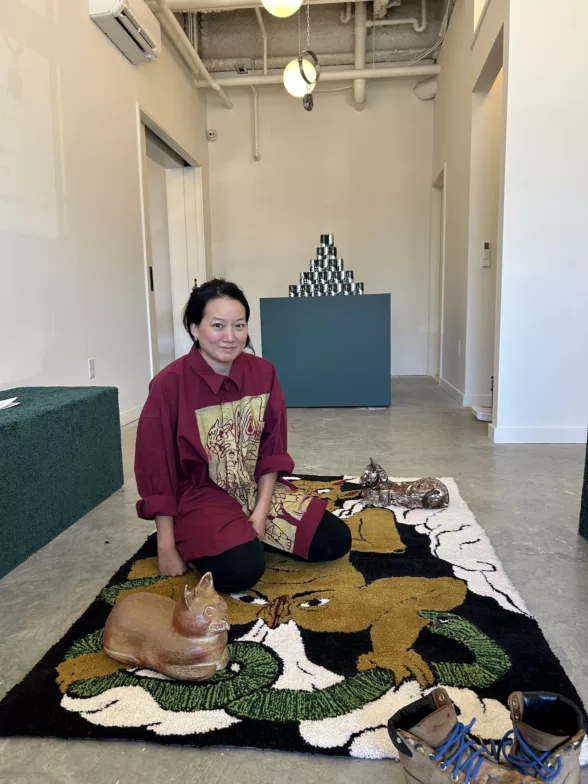
Joyce: What kind of relationship do you have with your cat? Do you see yourself as a caretaker? What kind of agency do you confer on your cat?
Candice: The work is not about care. One aspect of the work is about troubling this assumption that we are caretakers of the animals or that there is an uncomplicated notion of care happening. It’s tied to what I said earlier. Care is also this word like innocence that has a lot of unpacked dynamics of power within it: who gets to be in a position of caretaking and all the adjacent questions around autonomy and agency that raises. Agency is a very liberal humanist construct. In that context, I don’t think he has equal agency. He goes inside and outside freely so he could leave me if he wanted to, but he has dependencies that I’ve built into his life since I lured him inside as a feral kitten that makes him want to stay. But he has other forms of power over me because I am in love with him and he mind controls me and I do his bidding in some ways. So the power between us is not clear. I don’t have power over him completely but I have used my power to make him dependent on me.
Joyce: Camaraderie is developed through conflicts and hopes. I wonder if there is some kind of autonomy taken away from Roger?
Candice: I neutered him which I grueled over but ultimately chose to do. It’s a huge thing to take away someone’s sexual and reproductive ability and alter how it affects their mood and hormones. But because I’ve already brought Roger into this relationship of dependency, I didn’t feel right letting him be out there making feral kittens that I couldn’t care for. But I think the question of autonomy is also a lot more complicated than the ways I’ve taken it away or restricted it in his individual life.
Joyce: It’s complicated. Ethics of care that uphold companionship also challenge the promise of cohabitation. I heard in the exhibition there will be a seltzer mixed with fish sauce for visitors to buy and drink. How did you come about the idea?
Candice: During the meeting, we joked alot about commodities. I have all these great ideas for things I think could be the next big trend. In California especially there’s such a wellness culture that I find fascinating. There was a broth trend for awhile and all these different kinds of energy health drinks. So I suggested we should make Broth Soda, a canned drink that is something good for you but also something you can drink with your cat because I love when Roger eats or drinks things from the same bowl as me. It fills me with delight. So it came about as a kind of joke but we pursued it seriously..
Joyce: It sounds like an elixir. What does drinking a Broth Soda implicate?
Candice: In 2012 or 2013 when I started making work with a lot of liquid and organic materials, I was thinking about entanglement and the way that our bodies are porous and changing and changed by the world. And I was thinking through that subject matter by looking at the histories of bacteria, viruses, and insects that crossed the oceans, as well as plants and people and animals. Later in 2015, I was making work about parasites and fungi and I found out that for two years I had actually had a parasite living in my intestine but I didn’t realize it. It was controlling my mind’s interests from within! In 2016, in my collaborative work with P.Staff on Hormonal Fog[6] we made this testosterone-inhibiting fog as a provocation and a reminder for people that you’re always ingesting things and being changed as you’re moving through the world and at the same time you are changing it and having an effect on it. Purity is not possible. Marking a border, or any kind of fortress mentality, is not possible. The idea of entanglement and porosity is always important to me in the work as a way to rethink the enlightenment subject of rationality and distance. A lot of the work I make is very material and sensorial for that reason, to remind people that they are always part of the artwork and part of the world as they taste, touch, or breathe it in.
Work that reflects on human morality, empathy, and kindness, in community
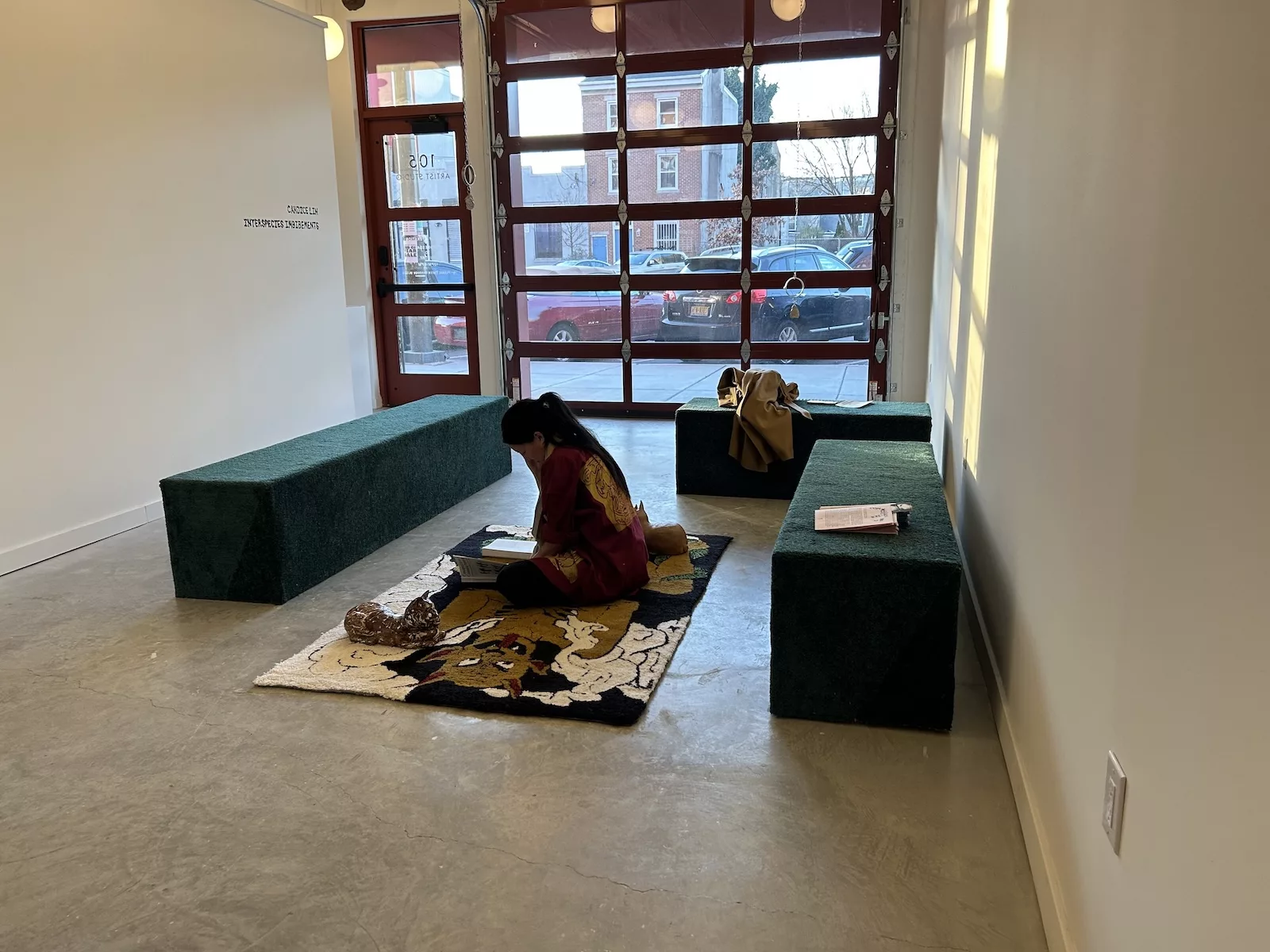
Candice Lin: Interspecies Imbibements is Candice Lin’s first solo exhibition in Philadelphia. Lin transforms Ulises’ project gallery into a shared domestic space between humans and their animal companions. Mutual living arrangements include three cat-shaped pillows made in glazed ceramic that are placed on a hand-tufted wool rug in the center. Five human collars are suspended from the ceiling by metal chains, each with a hanging locket inscribed with semi-caring, semi-sinister interactions between humans and non-human animals. Though the setup seems to be more relatable than Lin’s previous lithium battery factory piece in which the cat-demons reside, the constructed view constantly provokes tensions that seeks a considerable level of compromise in cohabiting with domestic cats.
As part of the show, there is “Broth Soda, “a canned beverage produced specifically for Ulises. It’s a seltzer mixed with fish sauce that viewers can purchase at $2.50 and drink together with their cats or other animals. Through the collective sensory experience, whether it’s drinking or smelling, visitors are invited to engage with the fizzy materials as the particles are getting through their bodies, probably something they have never thought about before.
The work may not only destabilize your notions of physical boundaries, but also create porous boundaries of conventional narratives that have been used in human-animal companionship. In the last two decades, animal studies have emerged worldwide as a new academic discipline. The studies strive to understand human-animal relationships in connection with animal rights movements, ethics of care, ecology, feminism, human rights, and postcolonial studies. Lin’s cats are not the sarcastic narrators of humanity like the cat in Sōseki Natsume’s novel I Am a Cat. Nor are they the representation of tension and anxiety in the world as Sigmund Freud suggests in his cat dream theory. Candice Lin’s work intends to disrupt the conventional perceptions about animals, reframing them as companion species that we live with together. The hanging human collars are great reminders of the reconfigured relationship between humans and their animals.
As our intake of “Both Soda” is more than we expect, human relationships with non-human species are more interconnected than we can imagine both directly and indirectly. Some of the unintended impacts that human actions have on other species could be altering ecosystems or consuming resources. In that sense, no relationship is free from conflicts or unpremeditated harm. Even in interpersonal relationships, humans often misconstrue what other humans want, where the communication is carried through the mode of language. Lin’s voice trembled slightly when she was talking about castration. Roger has within him the instinct for reproduction, but also loves the feeling of freedom that he can now pursue without weighing it down for people he is in a relationship with. There may be differing opinions on this, but one thing we can easily build consensus on is that considering animals as simple sources of unconditional love is abusive. The human-companion animal relationship, Donna Haraway says, is “not about unconditional love, but about seeking to inhabit an inter-subjective world that is about meeting the other in all the fleshly detail of a mortal relationship[7].”
The exhibition provides a platform for continuous reflection on the foundations of human morality, empathy, and kindness that are essential for living together, especially in the face of collective crises. Not only does the artist’s work pose questions on the ways in which interspecies cohabitation is governed by reciprocity and respect, but also, her attempt to channel other-than-human voices and forces effectively reveals the irony of violence. Violence often emerges during efforts to resolve a conflict turning the conflict resolution effort into a more entrenched struggle. Again, there are no definitive or final answers for how to solve this; it is an ongoing dialogue as we continue to navigate the world.
Candice Lin made a bunch of indigo-dye T-shirts fundraising for a family in Gaza, all purchasable at Ulises. Both have cat imagery. I bought a yellow T-shirt with a cat castration graphic with the phrase “too many rats not enough sex.”
Candice Lin: Interspecies Imbibements is on view at Ulises through March 16, 2025. Don’t miss Lin’s drawings of Roger on flyers and signages. Joyce will lead Ulises’s Dear Reader program on Saturday, January 25 in response to a reading/viewing list offered by the artist as a part of their programing for the exhibition.
Joyce Chung is the Curator at Asian Arts Initiative in Philadelphia, where she oversees the exhibition and performance program. Chung is interested in the complexity of identity and representation through the lens of the politics of place. Her curatorial projects focus on artistic exploration of struggles and hardships that are often overlooked, such as those of ethnic and gender minorities, women, and immigrant workers. Read more articles by Joyce Chung on Artblog.
[1] https://jameelartscentre.org/whats-on/candice-lin-night-stone/
[2] https://www.canalprojects.org/candice-lin
[3] https://www.labiennale.org/en/art/2022/milk-dreams/candice-lin
[4] https://carpenter.center/exhibitions/candice-lin-seeping-rotting-resting-weeping
[5] https://walkerart.org/calendar/2021/candice-lin/
[6] https://walkerart.org/magazine/candice-lin-patrick-staff-hormonal-fog/
[7] Donna Haraway, The Companion Species Manifesto: Dogs, People, and Significant Otherness (Chicago: The University of Chicago, 2003).


